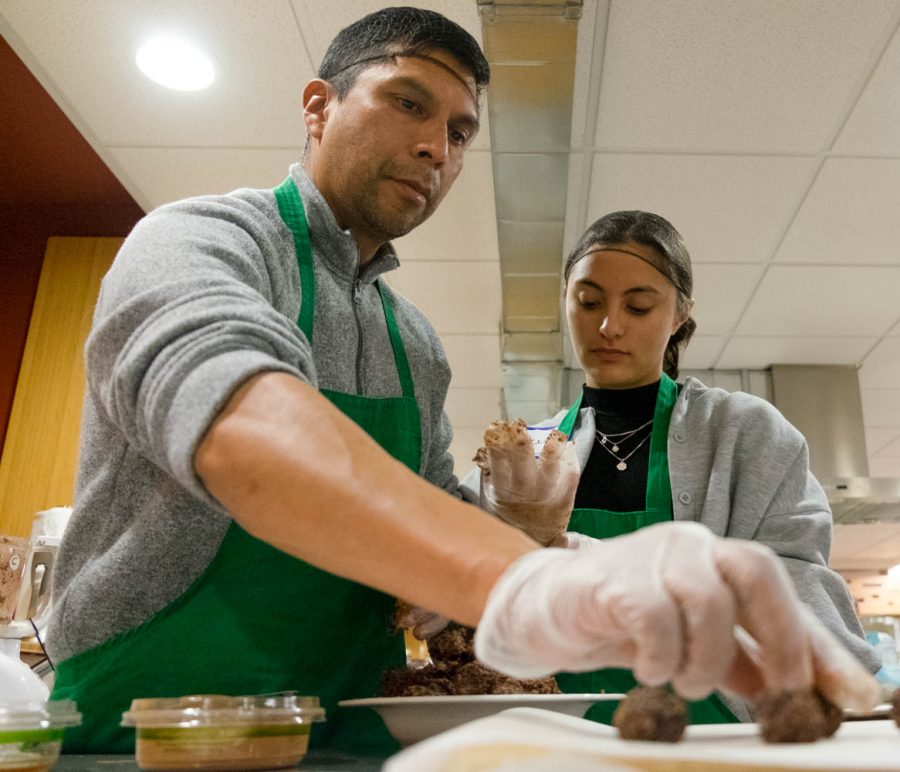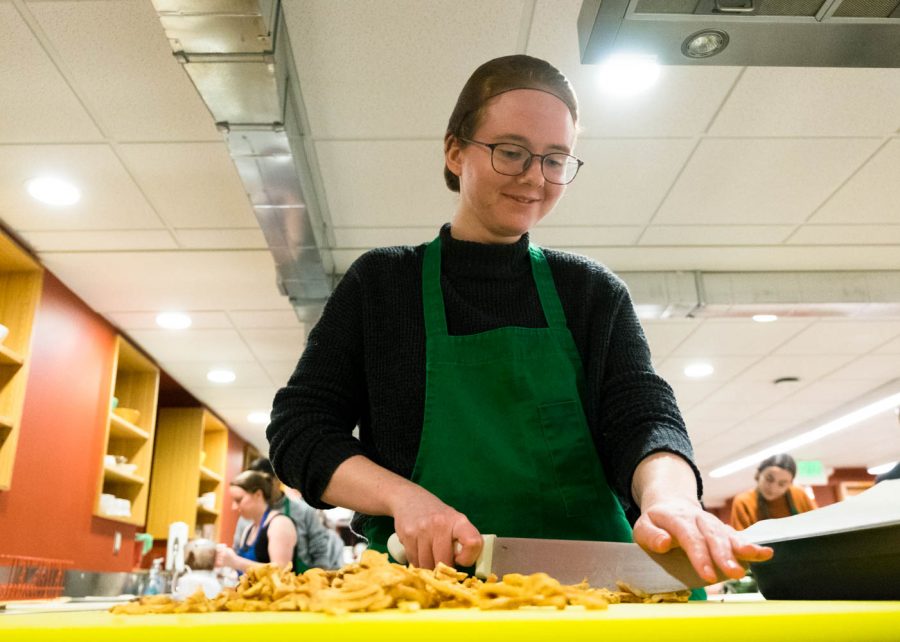Food insecurity hits close to home
College campuses experiencing hunger nationwide
Eldon and Reya Moore prepare fig and ginger truffles at the SPU Community Kitchen on Wednesday, Nov. 20.
November 21, 2019
The term ‘starving college student’ is frequently used, often off-hand or jokingly, to describe the lives of busy, financially challenged young adults at universities and community colleges.
But it may be more literal than many realize. Statistically, many college students are doing just what the phrase implies: starving.
“Data from more than 30,000 two- and four-year college students indicate that approximately half are food insecure,” Katharine M. Broton and Dr. Sara Goldrick-Rab wrote in the 2017 study “Going Without: An Exploration of Food and Housing Insecurity Among Undergraduates.”
According to data collected in 2016 by authors James Dubick, Brandon Mathews and Clare Cady for a report titled “Hunger on Campus: The Challenge of Food Insecurity for College Students,” food insecurity also disproportionately affects students of color and first generation college students over other groups.
Seattle Pacific University, it seems, is no different. Both SPU students and faculty readily admit that food insecurity is directly impacting students, and it is an issue that demands action.
“I never felt full when I was living in the dorms and eating the food on campus,” senior Katelyn McCollor said.
ASSP President Nathan Samayo remarked that it is important to approach the issues of homelessness and poverty through a more nuanced lens, accounting for all possible experiences of nutritional need. He wants to make sure all aspects are being attended to.
“When we talk about homelessness we just think of someone not having a house, which is correct, but there’s also other conversations; some folks have houses, but the other human needs such as food aren’t being met,” Samayo said. “ Those things can be scarce for them.”
According to Samayo and many others, food insecurity is not just a national issue, it directly affects our campus and many of our students. However, administrators, advisors and ASSP alike are beginning to take action to counteract some of that hunger.
Between ASSP plans in the works and under-the-radar actions by faculty, progress is slowly being made to create more resources.
SPU Dean of Students for Community Life Chuck Strawn said that he has spoken to many students who are, for one reason or another, not getting the nutrition they need.
“I have talked to students for whom food insecurity is very real on this campus, and also a lot of different ideologies of what that looks like,” Strawn said.
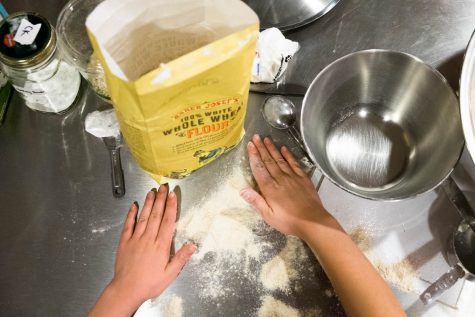
Lola Vann cleans up excess flour left over after she helped to prepare cinnamon pancakes at SPU Community Kitchen.
Strawn explained that, for some, ‘food insecurity’ means not being able to afford a meal, or groceries. For others, it can mean being too busy between school and work to have time for food until late at night — if at all.
“I think that a lot of people have changed their eating habits for school. Especially for commuters, we have to plan ahead if we need to bring food for lunch or for snacks while we’re at school,” senior Ally Wire said. “A lot of times, this means buying food items that are convenient but not necessarily healthy”
“I feel that when people go to college they eat things like cup of noodles. When you live in the dorms you’re less likely to make stuff on your own,” remarked McCollor.
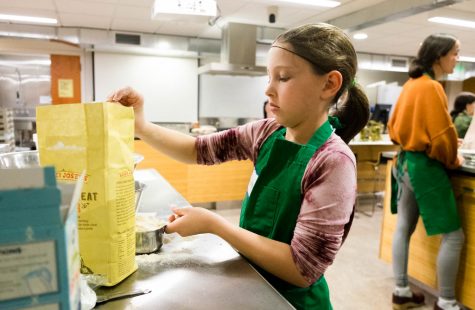
Lola Vann measures flour for pancakes and cookies at the SPU Community Kitchen.
“It is definitely something that all campuses struggle with, and we definitely have students that struggle with it here,” Strawn explained.
Strawn elaborated that, when he was younger, he experienced many of the same struggles around food that some SPU students, and college students nation-wide, are facing today. He said that he understands the perspective of these students.
He noted that Samayo is “especially passionate” about this subject, and while the issue has been discussed for a while, Samay recently has been taking more steps towards a plan of action.
“Its something he really wants to help our campus get ahold of and wrestle with,” Strawn said.
Samayo specified that he has a few goals for the year that he is personally championing, and he is beginning to have conversations about those goals, but they still need to be agreed upon and set into motion.
“With students’ meal plans, I would love to take the excess of the meals that they didn’t use at the end of the quarter to make block plans for people the next quarter, especially for commuter students who aren’t required to have a meal plan,” he said.
For a “more immediate” approach, he would also like to see a meal swipe donation system created for food insecure students.
“People could donate at least one meal swipe, and if twenty students donate one swipe … that’s somebody who [now] has a twenty-meal block plan.”
While those goals are being finalized and discussed, there are resources that students experiencing food insecurity can utilize.
Mya Kwon, staff dietician at SPU’s student counseling center, spoke to the resources currently available.
“We have a list of local food banks that students might be able to access,” Kwon explained.
“There are some churches around the campus that might have certain nights or days where everyone in the community is welcome to come have a meal.”
She also noted that SPU’s Community Kitchen provides a meal once per month, and is available to all students.
As far as on campus resources, Strawn recognizes that there is a lack of ways to help that do not require the student to ask an administrator.
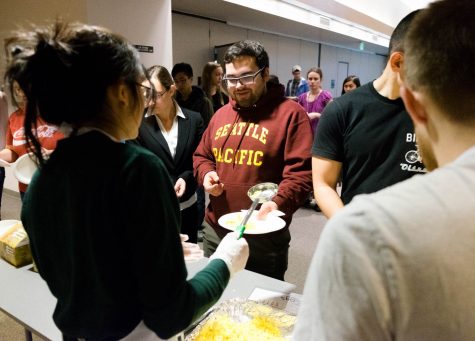
Thomas Gray, an SPU senior, is served a lunch of pancakes, sausages, and eggs at a Sharpen lunch.
“Off the top of my head there’s not any, and that’s part of the problem,” Strawn said.
“One of the things we’re finding statistically about food insecurity nationally is that it’s super embarrassing for people, they don’t want to say ‘hey I don’t have money to buy lunch today.’ As someone who has been there, I absolutely understand that.”
He mentioned the option of Gwinn guest meals, if students feel more comfortable asking their peers for help.
Student Elizabeth Davisson commented that Gwinn is a decent nutritional option, if students have access.
“You also have the freedom to choose to eat healthy foods, there’s a lot of those to choose from.”
Kwon noted a few places students might be able to go, such as her office in the counseling center and health services, where nurse practitioners are “well aware that this might be an issue in students that they might see in the clinic.”
Kwon wants students experiencing food insecurity to know that they have options, and they are not alone.
“That if they don’t know of the resources, there are people and departments they can reach out to for that,” she said.
In light of this issue, many SPU professors and faculty members have started ‘mini food banks’ by making free food available in their classrooms, clubs and other student-accessible areas for students to use anytime, no questions asked.
“Its great to know that there are other people on campus that are concerned and are trying to help students out,” Kwon remarked.
“One thing that we could do better … here is finding ways for all students to have a good access to food,” Samayo said. “If they have housing or especially if they don’t have housing, what are ways we can support them around their food needs.”
















































































